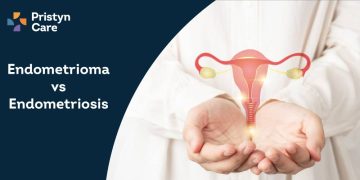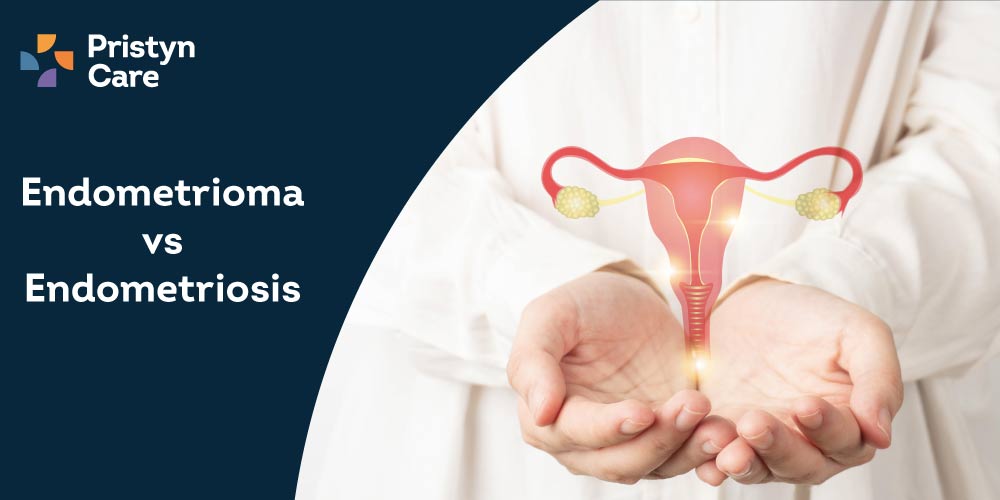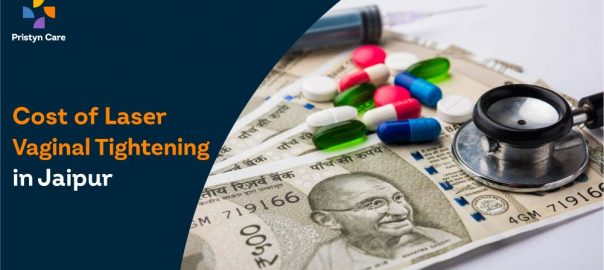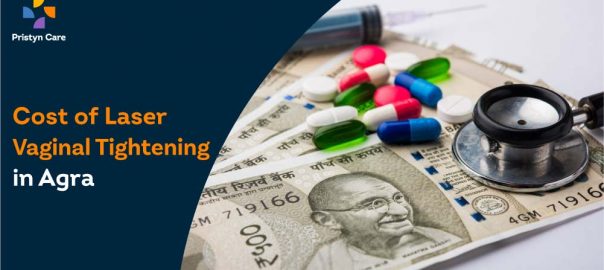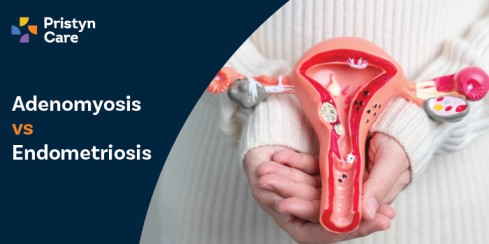![]() Views: 2,028
Views: 2,028
Endometrioma vs Endometriosis
This blog is intended to unravel a common healthcare topic that often confuses many: 'endometrioma vs endometriosis cyst'. It's essential to understand that these are two different conditions impacting women's health, and knowing the difference can lead to better treatment and potentially a quicker cure.
Dedicated Support at Every Step!
Our Doctors are available 24 hours a day, 7 days a week to help you!
Call Us0806-541-7961Table of Contents
Introduction
Endometriosis is a medical condition where tissue similar to the lining inside the uterus starts growing outside it. This abnormal growth can occur in various parts of the body, including the ovaries, fallopian tubes, and tissues lining the pelvis.
On the other hand, an endometrioma is a type of cyst formed when endometrial tissue (the tissue that normally lines the uterus) grows in the ovaries. They are also referred to as 'chocolate cysts' because of their dark appearance.
Understanding endometrioma vs endometriosis cyst is crucial as it aids in selecting the best treatment procedure. The cure for these conditions largely depends on early identification and proper medical intervention.
In this blog post, we will delve deeper into both of these conditions, shedding light on their symptoms, causes, diagnosis methods, and treatment options. Keeping yourself informed aids in a better understanding of your health and promotes proactive healthcare habits. So, let us begin our journey towards a healthier tomorrow.
No Cost EMI, Hassle-free Insurance Approval
Understanding Endometriosis
Endometriosis is a medical condition that primarily affects women of childbearing age. It occurs when tissue similar to the lining of the womb, known as endometrium, grows outside the uterine cavity. Commonly affected areas include the ovaries, fallopian tubes, and the tissues lining your pelvis.
- Symptoms of endometriosis: The primary symptoms of endometriosis are pain and discomfort. Women may experience severe menstrual cramps, pain during intercourse, discomfort during bowel movements or urination, excessive bleeding during periods, and even infertility in some cases.
- Causes of endometriosis: While the exact cause of endometriosis is unknown, hormonal imbalance and retrograde menstruation are often linked to this condition. Retrograde menstruation is when menstrual blood containing endometrial cells flows back into the pelvic cavity instead of leaving the body. These displaced endometrial cells stick to the pelvic walls and surfaces of pelvic organs, where they grow and continue to thicken and bleed over each menstrual cycle.
- Diagnosis: Doctors may suspect endometriosis based on your symptoms, but confirmation typically requires further testing. An ultrasound scan or magnetic resonance imaging (MRI) can provide images of cysts associated with endometriosis, but a definitive diagnosis usually requires a surgical procedure known as a laparoscopy.
- Risk Factors: Several factors increase your risk of developing endometriosis, including never giving birth, having a mother or sister with the condition, having menstrual cycles shorter than 27 days, or high levels of oestrogen in your body.
- Treatment: The best treatment for endometriosis often depends on its severity and whether you have plans for pregnancy. In India, treatment options range from pain medications to hormonal therapies like contraceptives or menopausal drugs. In severe cases, surgery might be necessary. Remember, despite endometriosis being a long-term condition, effective treatments are available that can help manage symptoms and improve your quality of life.
Understanding Endometrioma
Endometrioma, often known as an endometriosis cyst, is a type of ovarian cyst formed when endometrial tissue (the tissue that lines the womb) grows in the ovaries. This condition is different from endometriosis, although they are related. The key difference between endometrioma and an endometriosis cyst lies in their location: while endometriomas develop within the ovaries, endometriosis can occur anywhere in the body.
Symptoms of endometrioma can vary among women but generally encompass:
- Pain during menstrual periods
- Discomfort or pain during intercourse
- Difficulty in becoming pregnant
Diagnosing endometrioma often involves procedures like ultrasounds and sometimes laparoscopic surgery, where a small camera is used to look inside your abdomen. Your doctor may also order blood tests to measure levels of a substance called CA-125, which often increases in women with this condition.
In India, there are several treatment options for endometrioma. The best treatment depends largely on the patient's requirements and medical history. These can be broadly categorised into:
- Pain relief medication: To manage symptoms effectively
- Hormone therapy: This can help slow the growth of endometrial tissue and alleviate symptoms.
- Surgery: In severe cases or if other treatments don't provide relief, doctors might recommend surgical removal of the cysts.
Bear in mind that a cure for endometrioma isn't guaranteed even after treatment. However, with proper management and regular check-ups with your doctor, you can control your symptoms and improve your quality of life.
MBBS, DIPLOMA IN OBSTETRICS AND GYNAECOLOGY FELLOWSHIP IN GYNAECOLOGICAL LAPROSCOPIC SURGERIES.
₹2000₹600Consultation Fee
Comparing Endometriosis and Endometrioma
Similarities Between Endometriosis and Endometrioma
Endometriosis and endometrioma, while being two distinct conditions, share various commonalities. Here are some:
- Symptoms: Both of these conditions often present similar signs, including pelvic pain, especially during periods, and discomfort during sexual intercourse.
- Risk Factors: The risk factors for both conditions are also quite alike. These include factors like having a family history of the condition, starting your periods at an early age or missing the menopause late.
- Fertility Impact: Both endometriosis and endometrioma can have an adverse impact on fertility. These conditions may complicate conception and affect overall reproductive health.
The correlation between these two conditions is such that they are often mistaken for one another or wrongly diagnosed. Now let’s move on to the differences.
Differences Between Endometriosis and Endometrioma
Despite their similarities, it's crucial to distinguish between endometriosis and endometrioma. Let's outline how they differ:
- Position: While endometriosis occurs on the outside of the uterus lining (endometrium), the endometrioma vs endometriosis cyst difference lies in location, with endometrioma forming inside the ovaries.
- Procedure & Cure: The best treatment for each condition varies. For instance, endometriosis often benefits from hormonal therapy, whereas surgical removal is frequently employed for endometriomas.
Understanding these key differences can provide clarity about your own diagnosis and help you partner more effectively with your doctor to find the best treatment procedure suitable for you.
Remember, while there are numerous similarities between these two conditions, each has unique characteristics that require a tailored approach to cure. If you suspect you might have either of these conditions, seek medical advice promptly for timely diagnosis and management.
Health Implact of Endometriosis and Endometrioma
It's imperative to understand women's health issues in the context of cultural, social, and economic factors. Endometriosis affects nearly 25 million Indian women. The prevalence of ovary-related endometriomas is around 20–40% among these women. The implications of these conditions on women's health are major:
- Physical Impact: Chronic pain, heavy periods, and infertility are common symptoms. For some, it may lead to complications like ovarian cancer.
- Emotional Impact: Persistent pain and infertility can lead to severe emotional distress, affecting a woman’s mental well-being.
- Social Impact: In many parts of India, infertility brings social stigma, often leading to marital discord and isolation.
- Economic Impact: Treatment costs for these conditions can be high, adding another burden to families already struggling economically.
Identifying the best treatment or cure for both conditions depends on various factors, such as age, severity of symptoms, and personal circumstances:
- Medication: Painkillers and hormonal treatments can help manage symptoms.
- Surgery: In severe cases, surgery may be required—either laparoscopy (a minimally invasive procedure) or more extensive surgery (like hysterectomy).
It’s crucial that we raise awareness about these conditions and their implications. Early diagnosis and treatment can significantly improve the quality of life for millions of women in India.
Conclusion
To conclude, understanding the difference between endometrioma and endometriosis cysts is crucial. While both conditions relate to the growth of endometrial tissue, they manifest in different ways and require distinct treatment approaches.
Endometrioma, commonly known as an ovarian 'chocolate' cyst, specifically refers to a type of cyst formed when endometrial tissue grows in the ovaries. This condition often causes pelvic pain and can impact fertility. On the other hand, endometriosis is a broader term that refers to the condition where endometrial tissue grows outside the uterus. This can occur anywhere in the body but is most common in pelvic organs like the uterus, fallopian tubes, ovaries, and intestines.
Remember, an accurate diagnosis is key for both conditions. The procedures involved may include ultrasound scans or laparoscopy (a small camera inserted into your body to view the affected area). The best treatment depends on various factors, like your age, symptoms, future pregnancy plans, and the extent of your condition. It could range from medication to manage symptoms to surgery to remove cysts or affected tissue. Occasionally, a combination of treatments may be deemed necessary.
In essence, prioritize your health and ensure regular check-ups. Never ignore persistent discomfort or unusual symptoms; they could be signaling something more serious like endometrioma or endometriosis. Early detection and prompt cure are fundamental to effective management of these conditions.



